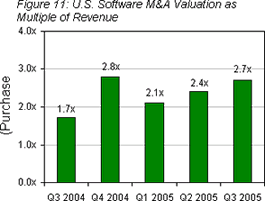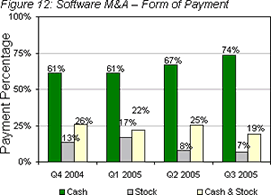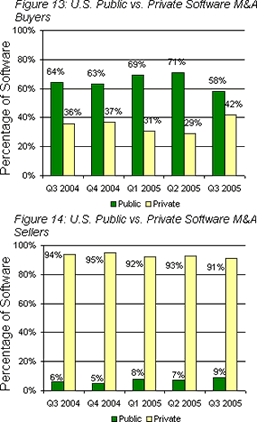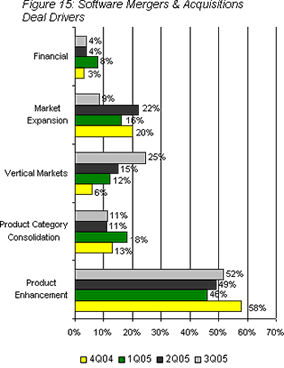|
|
| Home - Software M&A Review - Nov 05 Issue |
Software M&A - Robust Q3 Deals Despite Katrina
continued... page 3 |
 Software company exit valuations improved once again in 3Q05, for the third consecutive quarter. The median software company M&A valuation (based on equity purchase price) reached 2.7 times trailing-twelve-month (TTM) revenue in 3Q05, a 12.5% increase from the median M&A valuation of 2.4x in 2Q05 (Figure 11). Software company exit valuations improved once again in 3Q05, for the third consecutive quarter. The median software company M&A valuation (based on equity purchase price) reached 2.7 times trailing-twelve-month (TTM) revenue in 3Q05, a 12.5% increase from the median M&A valuation of 2.4x in 2Q05 (Figure 11).
Deal consideration in 3Q05 strongly favored cash over stock, reflecting sellers" growing uneasiness with an erratic stock market, abundant cash reserves and buyer reluctance to use stock it perceives to be undervalued. 74% of buyers in 3Q05 paid cash - up from 67% in 2Q05. Only 7% of buyers in 2Q05 paid all stock (vs. 8% in 2Q05) and 19% used a combination of cash and stock (vs. 25% in 2Q05) (Figure 12).
 Q3 was most noteworthy for its marked increase in the number of private buyers. We analyzed 152 third quarter software transactions in depth. Private equity firms and private software companies, mostly venture-backed, comprised an unprecedented 42% of the buyers, up 13% 2Q05. As for sellers, 91% of acquired companies were private and 9% were public, a distribution consistent with 2004 (Figure 13 and 14). Whether the increase in private buyers is an aberration or a trend remains to be seen. Q3 was most noteworthy for its marked increase in the number of private buyers. We analyzed 152 third quarter software transactions in depth. Private equity firms and private software companies, mostly venture-backed, comprised an unprecedented 42% of the buyers, up 13% 2Q05. As for sellers, 91% of acquired companies were private and 9% were public, a distribution consistent with 2004 (Figure 13 and 14). Whether the increase in private buyers is an aberration or a trend remains to be seen.
 Larger public software companies fetched higher valuations compared to their smaller peers, as buyers continued to favor acquisitions that yield short-term, top line growth. Over the last twelve months, the median revenue multiple (equity value) for acquired public companies with more than $100 million in revenue was 3.0x, but only 2.3x for acquired public companies with revenue less than $100 million. The median revenue multiple for acquired public companies with revenue between $20 million and $100 million was 2.7x while public companies with revenue between $10 million and $20 million was 1.8x. Companies whose revenue fell below $10 million commanded a 1.5x multiple of revenue. Larger public software companies fetched higher valuations compared to their smaller peers, as buyers continued to favor acquisitions that yield short-term, top line growth. Over the last twelve months, the median revenue multiple (equity value) for acquired public companies with more than $100 million in revenue was 3.0x, but only 2.3x for acquired public companies with revenue less than $100 million. The median revenue multiple for acquired public companies with revenue between $20 million and $100 million was 2.7x while public companies with revenue between $10 million and $20 million was 1.8x. Companies whose revenue fell below $10 million commanded a 1.5x multiple of revenue.
Valuations of privately held sellers, however, reflected a bit more strategic thinking on the part of buyers. The median revenue multiple for privately held sellers with revenue greater than $100 million was 2.3x, compared to 2.6x for companies with revenue less than $100 million. The median revenue multiple for acquired private companies with revenue between $20 million and $100 million was 2.8x while companies with revenue between $10 million and $20 million was 2.1x.
Mergers and Acquisitions: Buyer Motives
Product Extension
A deal-by-deal analysis of 152 third quarter software transactions reveals 52% of the buyers sought to enhance their current product suite by acquiring small and mid-cap companies targeting the same markets with highly complementary, best-of-breed, market proven products and technology (Figure 15). Their objectives were to better satisfy market requirements, differentiate further from the competition and obtain new sources of revenue. Sellers providing such product extension leverage commanded the highest multiple in 2Q05 (2.9x), compared with our other buyer motive categories. Examples include F5 Networks" acquisition of Swan Labs to expand its platform and enter into the high growth network acceleration market; Check Point's entry into the frenzied security software M&A realm by acquiring Sourcefire; and Business Objects" acquisition of SRC to enhance its own business performance management solution suite.
 Market Expansion Market Expansion
Buyers" appetites for new markets abated in the third quarter. Only 9% of buyers (vs. 22% in 2Q05) sought to accelerate their growth by acquiring software companies in other product categories, new geographic markets and new vertical markets. New market buyers included United Devices, a provider of high performance grid computing solutions, that acquired GridXpert, a Paris-based developer of enterprise grid middleware; Applied Wave Research, a developer of electronic design automation software that acquired APLAC, a provider of EDA software to the European and Nordic marketplace; and Market Insite Group, a developer of business intelligence tools, that acquired Asterop, a business intelligence firm with significant European presence.
|
|


|

